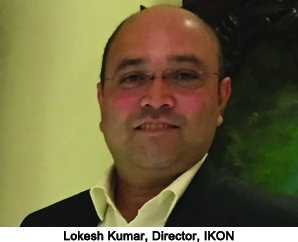Home » Viewpoints » There's enough for all, collaborate for more
There's enough for all, collaborate for more
By M4G Bureau - August 10, 2015
Lokesh Kumar, Director, IKON, advocates a win-win approach for the industry instead of cut-throat competition
 The OOH industry has been playing a significant role in the development of public infrastructure, such as, bus queue shelters, public restrooms, way-finding media, and street furniture in different cities and towns. Yet, the industry is perceived in certain quarters as an abode of unauthorised activities. Who is to be blamed for such a skewed perception? What do industry leaders do when the outdoor media gets bad press?
The OOH industry has been playing a significant role in the development of public infrastructure, such as, bus queue shelters, public restrooms, way-finding media, and street furniture in different cities and towns. Yet, the industry is perceived in certain quarters as an abode of unauthorised activities. Who is to be blamed for such a skewed perception? What do industry leaders do when the outdoor media gets bad press?Much of the responsibility for the poor perception, to my mind, rests on the shoulders of the industry leadership. We as an industry have not come together to leverage one another's strengths and capabilities to tap the existing growth opportunities and to explore and create new ones. Instead, we seem to be dissipating our energies by engaging in small skirmishes and battles to win small businesses. When a problem descends on the industry, there are no concerted actions seen to protect the interests of the concerned stakeholders. It is high time that we changed our outlook and approach.
If you look around, the world is changing at an exponential pace. Closer home, regulatory authorities in different states as well as the industry body IOAA have initiated several steps to standardise and professionalise the Indian OOH industry. To illustrate this, the Karnataka Government is working in tandem with the Bengaluru OOH industry to identify and root out unauthorized media in the city. Efforts are underway to make this information available online to help all concerned stakeholders to take the right business decisions.
In another case, the Kerala OOH industry association has been working with the state government to identify and remove unauthorised media in the state and thereby standardise the industry practices.
Positive, concerted efforts like these will go a long way toward placing the industry on a high pedestal - leading to more business flowing into the OOH fold. That's a win-win proposition we can ill afford to ignore.
To take this forward, I would suggest that the IOAA and its regional wings should function as industry-wide platforms to facilitate the collaborative positive actions.
While the aforementioned suggestions are essentially directed at the media owning firms, the specialist OOH agencies on their part should look to follow the guidelines laid down by the industry while planning and executing advertising campaigns. The agencies should also sensitise their respective clients on the industry guidelines so that there is no room for ambiguity in the understanding of standard practices.
Collaboration is an imperative for the industry keeping in view the current business scenarios. On one side, the size of the market geographically is growing but the size of the CBD areas is still fixed and largely cluttered. On the other side, the size of the OOH business is degrowing via-a-vis the overall share of ads across all medias by 0.2%.
So, what do we need to do to tackle this situation? To the media owning business, I would suggest the path of consolidation. That is, OOH media owners should look to consolidate their business instead of focusing upon individual monopolisation.
Firms should consolidate their business to:
• Create single marketing / sales points
• Create better quality medias (higher investment on the structures)
• Adopt advanced technologies
• Demonstrate the significance and size of the industry to the concerned government / statutory bodies
By setting up public limited companies, the industry is likely to attract a sizeable number of small retail investors to invest in the business.
The specialist and media agencies on their part could leverage one another's strengths - in terms of regional footprints. Further, to meet the rising expectations of clients, the agencies should look to create a stronger talent pool through training and development. Initiatives like these can be taken up at the industry level.
Above all, the agencies should work closely with the IOAA to bring in greater transparency and professionalism in the OOH business. This way, long-standing issues like payment delays and defaults will get addressed and the trust factor will grow manifold.
I am sure each of you have these thoughts or better ideas. Some of you would have tried them out and perhaps failed in the attempt. But I am sure the times are changing, so persistence will yield the right results for you and for the industry.
OOH industry in India is in the nascent stage of change, but it is large enough for all. Let us collaborate and as a first step get the industry status for our business in this decade.

Stay on top of OOH media trends
Advertisement







